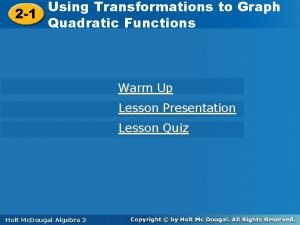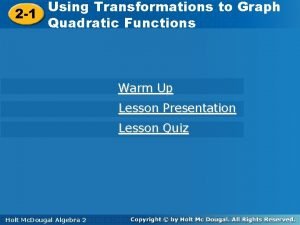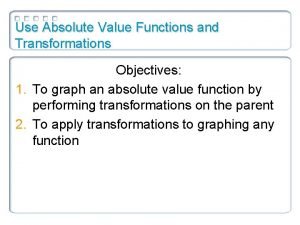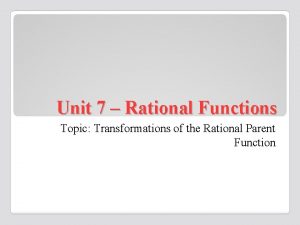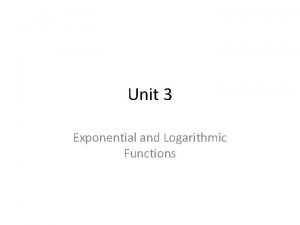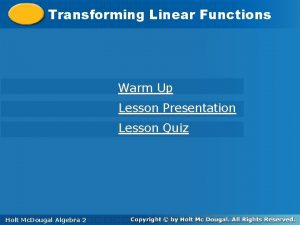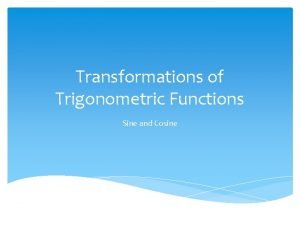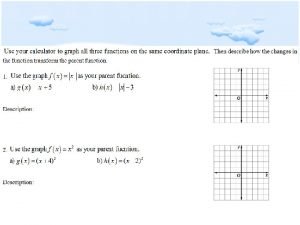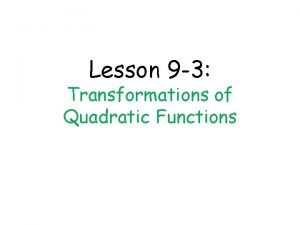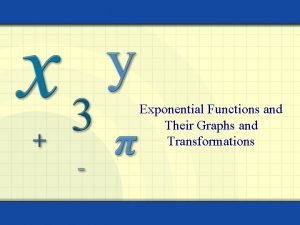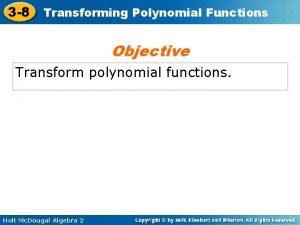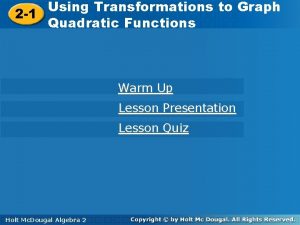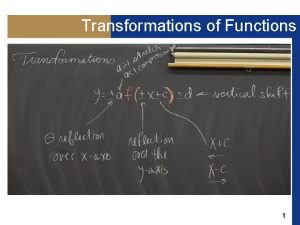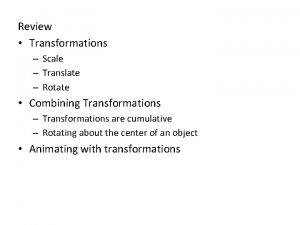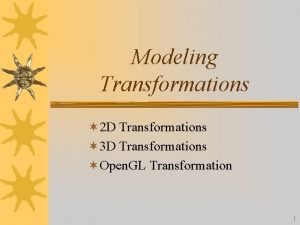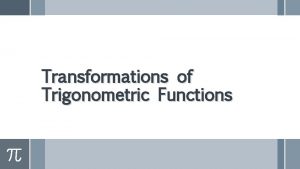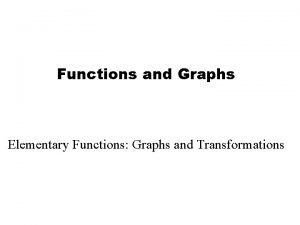1 6 Transformations of Functions Transformations Review Transformations

















- Slides: 17

1. 6 Transformations of Functions Transformations: Review Transformations We will be looking at functions from our Transformations library of functions and seeing how various modifications to the functions transform Transformations them. Transformations

VERTICAL TRANSLATIONS As you can see, a number added or subtracted from a function will cause a vertical shift or translation of the function. Above is the graph of What would f(x) +- 31 look like? (This would mean taking all the function values and adding subtracting 3 from them). 1 to them).

VERTICAL TRANSLATIONS The graph f(x) + k, where k is any real number is the graph of f(x) that is vertically shifted by k. If k is positive it will shift up. If k is negative it will shift down Above is the graph of What would f(x) + 2 look like? What would f(x) - 4 look like?

HORIZONTAL TRANSLATIONS Above is the graph of As you can see, a number added or subtracted from the x will cause a horizontal shift or translation in the function but opposite way of the sign of the number. What would f(x+2) look like? (This would mean taking all the xx f(x-1) look values and adding 2 to 1 them putting them inthem the function). subtracting frombefore them before in the function).

HORIZONTAL TRANSLATIONS So The thegraph f(x-h), where h is any real number is the graph of f(x) that butishorizontally shifted by h. shift right 3 Above is the graph of What would f(x+1) look like? What would f(x-3) look like? So shift along the x-axis by 3

up 3 We could have a function that is transformed or translated both vertically AND horizontally. left 2 Above is the graph of What would the graph of look like?

VERTICAL DILATION S t r e t c h i n g HORIZONTAL DILATION and Compressing

VERTICAL DILATION If we multiply a function by a non-zero real number it has the affect of either stretching or compressing the function because it causes the function value (the y value) to be multiplied by that number.

Notice for any x on the graph, the new (red) graph (green) graph hashas ay value a y value that is 2 is 4 times as much as the original (blue) graph's y value. Above is the graph of What would 2 f(x) look like? What would 4 f(x) look like? The graph af(x), where a is any real number GREATER THAN 1, is the graph of f(x) that is vertically stretched or dilated by a factor of a.

What if the value of a was positive but less than 1? Notice for any x on the graph, the new (green) (red) graph has a ya y graph has 1/2 as much as the value that is 1/4 original (blue) graph's y value. Above is the graph of What would 1/2 f(x) look like? What would 1/4 f(x) look like? The graph af(x), where a is 0 < a < 1, is the graph of f(x) that is vertically compressed or dilated by a factor of a.

S t r e t c h i n g HORIZONTAL DILATION If we have x-variable multiplied by a non-zero real number c, that is f(cx), it has the affect of either horizontal stretching or compressing the function, because for graphing each x value is to be divided by that number. and Compressing The graph f(cx), where c is c > 1, is the graph of f(x) that is horizontally compressed by a factor of c (x-values becoming smaller). The graph f(cx), where c is 0 < c < 1, is the graph of f(x) that is horizontally stretched by a factor of c (x-values becoming bigger).

What if the value of a was negative? The graph - f(x) is a reflection about the x-axis of the graph of f(x). Notice any x on the new (red) graph has a y value that is the negative of the original (blue) graph's y value. (The new graph is obtained by reflecting the function over the x-axis) Above is the graph of What would - f(x) look like?

There is one last transformation we want to look at. Notice any x on the new (red) graph has an x value that is the negative of the original (blue) graph's x value. The graph f(-x) is a reflection about the y-axis of the graph of f(x). (The new graph is obtained by reflecting the function over the y-axis) Above is the graph of What would f(-x) look like? (This means we are going to take the negative of x before putting in the function)

Summary of Transformations So Far FOLLOW ORDER OF OPERATIONS If a > 1, then vertical dilation or stretch by a factor of a If 0 < a < 1, then vertical dilation or compression (shrink) by a factor of a If a < 0, then reflection about the x-axis (as well as being dilated by a factor of a) vertical translation of k f(-x) reflection about y-axis horizontal translation of h (opposite sign of number with the x)

Graphing from a parent function by transformations continues: Example Describe how the graph of by transforming the graph of Solution can be obtained Sketch its graph. Since the basic graph is the vertex of the parabola is shifted right 4 units. Since the coefficient of is – 3, the graph is stretched vertically by a factor of 3 and then reflected across the x-axis. The constant +5 indicates the vertex shifts up 5 units. reflect across the x-axis vertical stretch by a factor of 3 shift 4 units right shift 5 units up

There is one more Transformation we need to know. Always follow ORDER of OPERATIONS If a > 1, then vertical dilation or stretch by a factor of a If 0 < a < 1, then vertical dilation or compression by a factor of a If a < 0, then reflection about the x-axis (as well as being dilated by a factor of a) vertical translation of k f(-x) reflection about y-axis horizontal translation (opposite sign of number with the x) horizontal dilation by a factor of 1/c

Practice time! Given function f(x) graph
 Transformations review game
Transformations review game Using transformations to graph quadratic functions
Using transformations to graph quadratic functions Quadratic transformations quiz
Quadratic transformations quiz Transformations of linear and absolute value functions
Transformations of linear and absolute value functions Rational parent function
Rational parent function Examples of exponential equations
Examples of exponential equations 3-3 transforming linear functions
3-3 transforming linear functions Sine cosine partner
Sine cosine partner 7 parent functions
7 parent functions Function transformations
Function transformations Dilations of quadratic functions
Dilations of quadratic functions Transformations of functions
Transformations of functions Translating exponential functions
Translating exponential functions 2-7 parent functions and transformations answer key
2-7 parent functions and transformations answer key 8-4 modeling with quadratic functions
8-4 modeling with quadratic functions Exponential transformations
Exponential transformations Transformation of polynomial functions
Transformation of polynomial functions Using transformations to graph quadratic functions
Using transformations to graph quadratic functions

